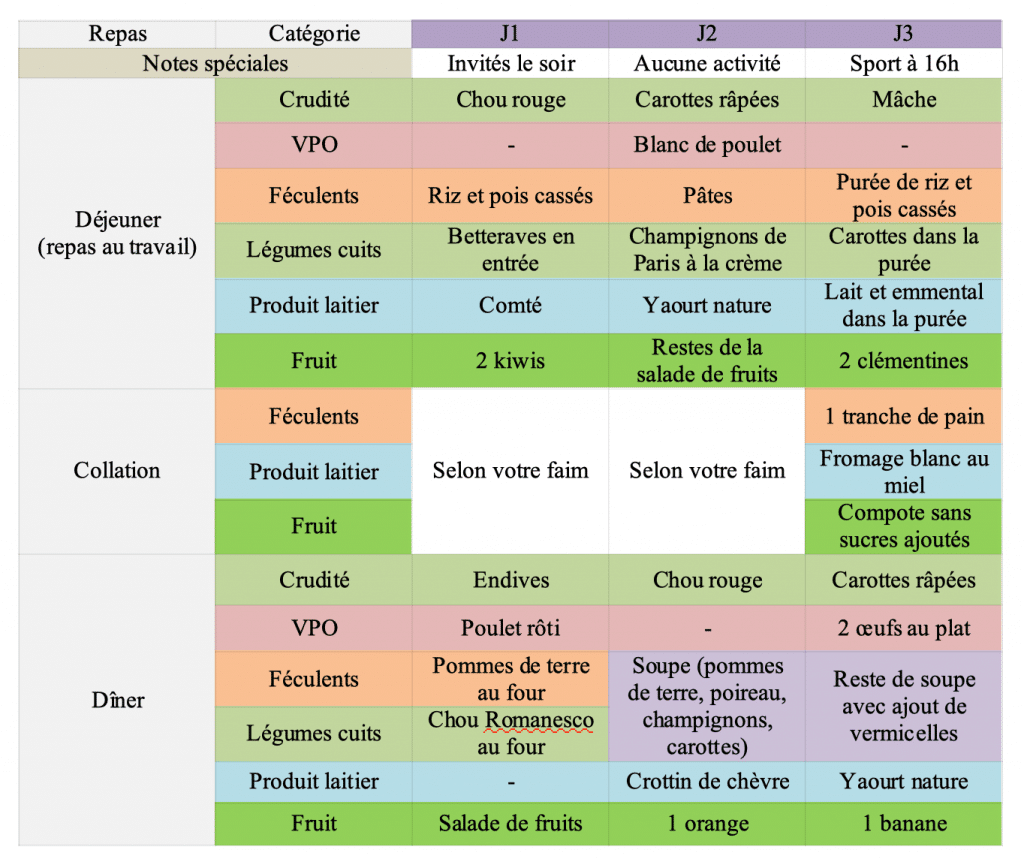[Article updated on 19/09/2023]
I hear this question very often in my daily life as a freelance dietitian! Indeed, it is not always easy to know which foods to choose when shopping to have enough stock for the week, to eat balanced, varied meals without spending 2 hours a day cooking!
Rest assured, eating a balanced and varied diet does not necessarily require a lot of time in the kitchen, but a little organization!
For reminders:
- Eating a balanced diet means “consuming foods from each food category every day”: starchy foods, fruits and vegetables, dairy products…
- Eating varied means “eating different foods within each of the food categories”: if you eat an apple at each meal, you do bring a piece of fruit each time (this contributes to dietary balance), but you do not vary not. Change fruit with each meal (kiwis, oranges, apples, bananas, etc.) to vary your fruits!
Here is now the first keys to learning how to organize your menus of the week:
1time step: Project yourself into your coming week in order to be able to do your shopping
To create your menus, you must first determine the types of meals you will have during your week, as well as the number of people to plan for each meal:
- How many meals will you make at home?
- How many people will be at the table?
- Do you have a family/friends meal planned?
- Do you have to prepare lunch meals at work?
- Do you have special schedules for a day of the week?
- Are you going to do sports?
- Do you have any particular desires?
So many questions that will allow you to better anticipate your menus and plan the quantities needed for your week.

2th step: Make a list of all the foods you know and cook easily
That may seem tedious at first, but once it job is done, it will save you a lot of time! YOU You can start with the foods of the current season and list foods you cook easily by category. YOU will be able to complete this list as the seasons and foods that you will discover. Let’s take the example of the month in course (February) to illustrate this point:
Main categories : OPV1, starchy foods, vegetables, dairy products, fruits
Season : winter
Food that I know by category:
- VPO: Beef (steak, entrecôte, roast, etc.), eggs (hard-boiled, fried, soft-boiled, omelette, etc.), ham (white, country, roast, etc.), salmon (paupiette, fillet, back, smoked, etc.) , lamb (leg, chops, etc.)
- Starchy foods: rice (Creole, pilaf), pasta (gratined, with butter, tomato sauce, plain, etc.), potatoes (steamed, sautéed, baked, fries, etc.), dried vegetables (split peas, lentils, dried beans, etc.)
- Vegetables: endives (raw, braised, béchamel, etc.), cabbage (steamed, soup, gratin, etc.), carrots (grated, braised, sautéed, soup, etc.), leek (salted tart, soup, in vinaigrette, etc.)
- Dairy products: yogurts, white cheeses, cheeses (comté, camembert, blue cheese, goat droppings, grated emmental, etc.)
- Fruits: raw, cooked in compote (kiwi, clementine, orange, grapefruit, banana, etc.)
A Once your list is drawn up, most of the work is done!
3th step: Create your menus by referring to your list
THE time has finally come to create your menus!
Draw a chart to represent your week and your meals. Indicate all the specific elements that will guide you for your reflection: your sporting activities, your meals to take at work, meals with friends, etc.
Note 1: The first mistake that comes up very often when we wish to establish a week of balanced and varied menus, It’s about wanting to vary your meals too much! Therefore, we found myself with too many products at home important and we spend a phenomenal time cooking each day !
Note 2: The second mistake is wanting to think about your menus day after day… It’s the best way to lose track and to be out of ideas.
Let’s start again our example for menus in the middle of February. For simplify, we are going to start with 3 days of menus, concentrating on lunches and dinners:
- Choose your OPV: 1 serving per day is sufficient if you do not practice sports activity intensively. Remember to plan your leftovers and use them during the week.
- Choose your starchy foods: you can indicate the accompanying sauces if you wish.
- Choose your cooked and raw vegetables: remember to reuse vegetables already prepared for new preparations.
- Choose your dairy products and fruits.

If you run out of ideas, this is where your food list previously drawn up can help you! She will unblock you from any blank page!
As you can see in this example, the menus are varied in presentation and choice of foods. However, these are simple, quick meals that are easy to prepare, store and transport to work. Eating variety does not mean eating differently at every meal. Choose certain foods for one week and the next week, change!
YOU have all the keys to designing your balanced and varied menus From now on ! All you have to do is make your lists of food according to the seasons!
Do not forget not that creating menus is a profession (that of dieticians) and that it is therefore normal that this may seem to you to be a exercise a little difficult at the beginning… But with a little training, you will succeed for sure!
1 OPV: Meat, Fish, Eggs
